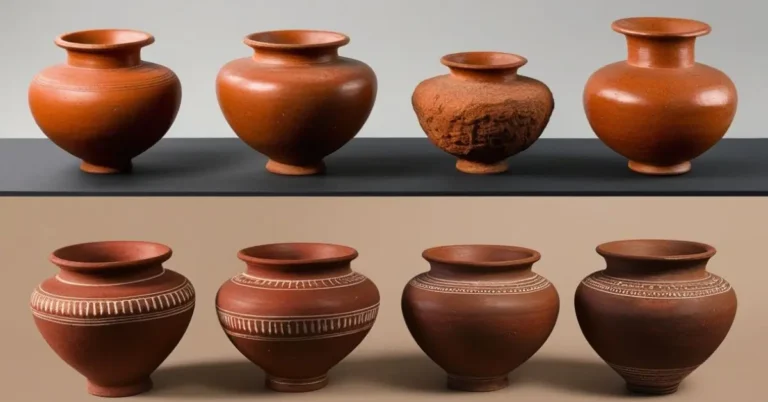Ochre pots, a hallmark of the Ochre-Coloured Pottery (OCP) culture, are one of the most significant archaeological findings from India’s Bronze Age. Spanning roughly 2000–1500 BCE, these artifacts serve as windows into an era of cultural transformation, bridging the decline of the Harappan civilization and the rise of the Vedic age. Distinguished by their reddish-brown color, ochre pots provide insights into ancient lifestyles, trade, and technological evolution.
Defining Ochre Pots
Ochre pots are wheel-made ceramics characterized by a thick ochre-red slip, likely resulting from poor firing techniques and environmental exposure. Their porous surfaces, black-painted bands, and occasional incised patterns highlight the craftsmanship of this early society. Unlike purely utilitarian pottery, these vessels were often associated with copper hoards, suggesting a dual purpose of practicality and ritual significance.
Geographical Spread of OCP Culture
The Ochre-Coloured Pottery culture flourished in the Indo-Gangetic plains, particularly in present-day Rajasthan, Punjab, Uttar Pradesh, and Haryana. Evidence of its spread has also been found in Chota Nagpur and Madhya Pradesh. Key excavation sites include:
- Jodhpura (Rajasthan): The earliest evidence of OCP, discovered alongside burial remains.
- Atranjikhera and Lal Qila (Uttar Pradesh): Rich findings of ochre pottery, copper implements, and terracotta figurines.
These findings demonstrate the widespread influence of OCP culture, marking it as a transitional phase between Harappan and later Iron Age traditions.
Cultural Practices of OCP Communities
1. Agriculture and Food Production
OCP societies were agrarian, cultivating crops like rice, barley, and lentils. Advanced irrigation techniques and fertile Gangetic plains allowed for surplus food production. Farming tools unearthed at excavation sites reveal an intimate understanding of soil and water management.
2. Animal Husbandry
Domestication played a crucial role in OCP communities, with evidence of cattle, sheep, goats, pigs, and even horses. These animals provided milk, meat, and labor while contributing to trade and transportation systems. Terracotta animal figurines suggest their significance in daily life and rituals.
3. Trade and Exchange
The discovery of copper hoards near ochre pots indicates robust trade networks. Copper, essential for tools and ornaments, likely came from the Aravalli hills. Additionally, similarities with Late Harappan pottery suggest cultural exchanges between these societies.
4. Religious Practices
Many ochre pots have been found in burial contexts, hinting at their use in funerary rituals. These pots likely held offerings or ashes, symbolizing the spiritual beliefs of the time. Their association with copper anthropomorphic figures suggests a link to early forms of idol worship.
Technological Advancements in Pottery
The creation of ochre pots involved wheel-making, a significant technological advancement over hand-molding methods. However, poor firing techniques resulted in brittle ceramics prone to damage. This flaw, ironically, aids modern archaeology, as broken sherds are abundant across excavation sites. Decorations such as black-painted bands demonstrate aesthetic sensibilities and cultural identity.
Comparison with Other Pottery Traditions
| Feature | Ochre-Coloured Pottery | Painted Grey Ware (PGW) | Late Harappan Pottery |
|---|---|---|---|
| Timeline | 2000–1500 BCE | 1200–600 BCE | 1900–1300 BCE |
| Material | Porous, poorly fired clay | Fine, well-fired pottery | Durable, varied ceramics |
| Decorative Features | Black bands, incised lines | Geometric patterns | Painted and unpainted styles |
| Usage | Ritualistic, domestic | Domestic and luxury | Trade, rituals, and storage |
This comparison reveals how OCP culture bridged the technological and artistic gap between the Harappan and later Vedic traditions.
Challenges in Understanding OCP Culture
Despite its significance, the OCP culture presents several challenges:
- Fragmentary Evidence: Poorly fired pottery is less durable, resulting in incomplete artifacts.
- Uncertain Linguistic Links: The language of OCP people remains a topic of debate, with hypotheses ranging from early Indo-Aryan to post-Harappan dialects.
- Cultural Continuity: While OCP shares traits with the Harappan culture, its independence as a distinct civilization is still questioned.
Significance in Indian History
Ochre pots symbolize a pivotal chapter in India’s ancient history. They represent:
- Cultural Transition: The decline of urban Harappan culture and the rise of rural, agrarian Vedic traditions.
- Technological Progress: Advances in pottery, metallurgy, and agriculture.
- Societal Structure: Evidence of hierarchical societies with trade, rituals, and animal husbandry playing central roles.
Modern Relevance
Studying OCP culture enhances our understanding of ancient India’s resilience and adaptability. These pots highlight how societies adapted to environmental and cultural shifts, laying the foundation for future civilizations. For archaeologists, they serve as crucial evidence of early human ingenuity and cross-cultural interactions.
Conclusion
Ochre pots are more than relics; they encapsulate an era of transformation and innovation in ancient India. From agricultural practices to spiritual beliefs, they offer invaluable insights into the lives of early Indian societies. Their study not only enriches our knowledge of the past but also underscores the importance of preserving cultural heritage for future generations.

